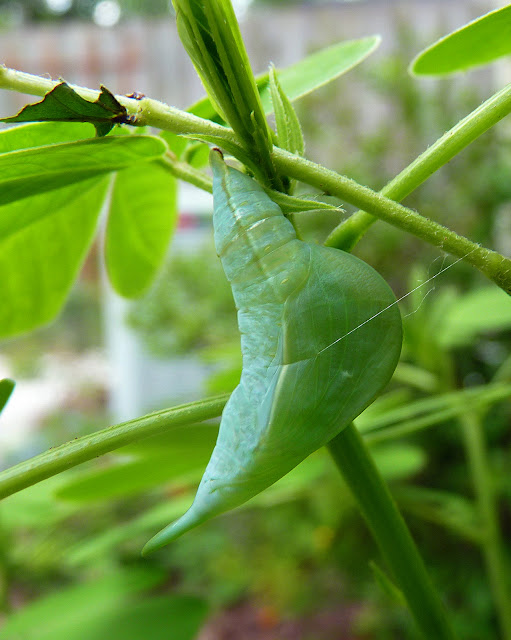One of our goals in 2010 was to attract more sulphur butterflies to My Florida Backyard, and we're pleased to announce that we've certainly succeeded. By including host plants like Winter Cassia (Cassia bicapsularis), Candlestick Cassia (Senna alata), and Partridge Pea (Chamaecrista fasciculata), we've been able to draw these butterflies and their caterpillars in droves, and bright flashes of yellow are now a common sight. One host plant in particular seems popular lately, a plant commonly known as Sicklepod Senna (Senna obtusifolia).
Sicklepod has small yellow flowers followed by sickle-shaped seed pods. It's a plant you'll certainly never find in a garden center - it's considered a nuisance weed by Florida farmers. Indeed, left to its own devices it will spread quickly and grow prodigiously, so if you choose to grow it, it's best to control it by pinching off the seed pods before they have a chance to burst and spread. Despite the reputation, Sicklepod can be a valuable addition to butterfly gardens as a host plant for Sleepy Orange, Cloudless Sulphur, and Orange-Barred Sulphur caterpillars.
The Orange-Barred Sulphur caterpillar is particularly striking with its black stripes and spiricles.
It grows to a length of about 2 inches before creating a well camouflaged chrysalis that looks rather like a leaf, blending nicely with the foliage around it.
The butterfly itself is pretty hard to get good pictures of, like most sulphurs, as it never seems to linger in one place for long. It is a large yellow butterfly with beautiful orange markings. Click here to see a nice picture of one over at Tales From the Butterfly Garden.
It's nice to set goals and actually achieve them, so My Florida Backyard is feeling pretty pleased with our accomplishment. By seeking out and adding the right plants, we've been able to bring several new species to our backyard. This is the ultimate goal of wildlife gardening, and it's very satisfying when you realize you've done what you set out to do!




Your wonderful post is a great example of setting goals and planning how to achieve them. I know that it must be very satisfying to you as the Cloudless sulphurs are beautiful and it's very enjoyable to watch them floating around the garden. I love finding them on our candlestick plant.
ReplyDeleteYour butterfly garden is really producing the desired results. I have the winter cassia and the sulphurs are always on it. I'm always amazed that they don't even care if there are blooms. How they find it is intriguing. Do butterflies smell their host plants?
ReplyDeleteNanaK - As to how butterflies locate their host plants... butterflies "taste" with their feet. They can tell if the plant is the right one by landing on it. How they know which plant is the right one for their species - well, that's one of those great mysteries of nature!
ReplyDeleteThanks for sharing the catepillar picture. I've newly discovered the butterfly hobby, but sites like yours make it easy to learn.
ReplyDeleteI was trimming my Jatropha one day. After I cut one small branch off I noticed it had a cocoon which was a different shape than I had seen before....exactly like the picture you have posted. I carefully laid the branch across a hanging basket. Sure enough, one morning I went out just in time to see a beautiful sulpher fly away.
ReplyDelete